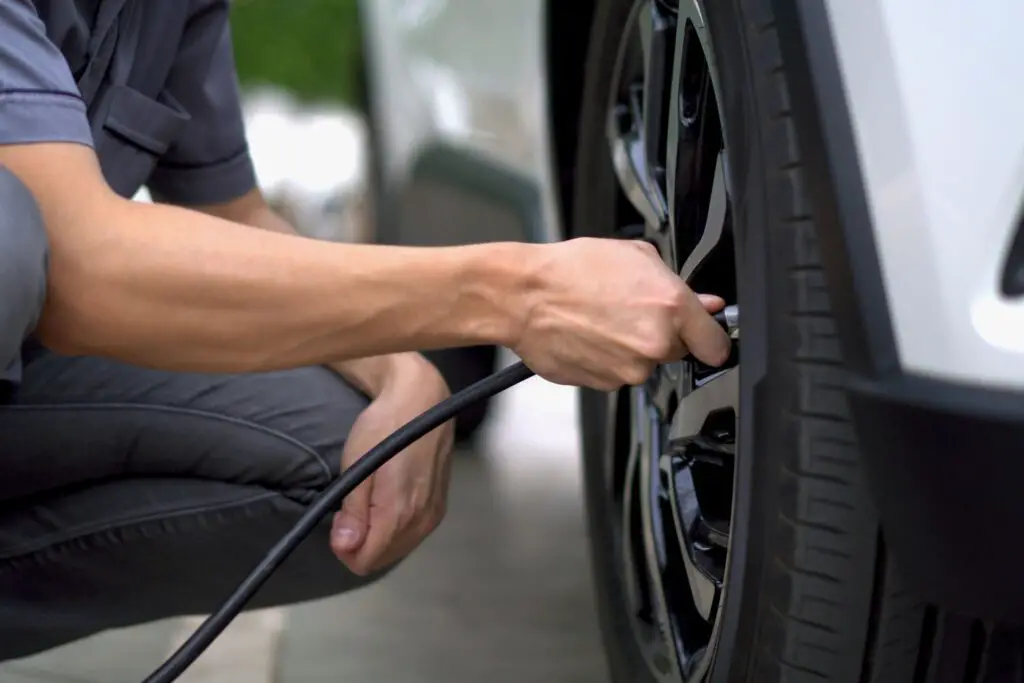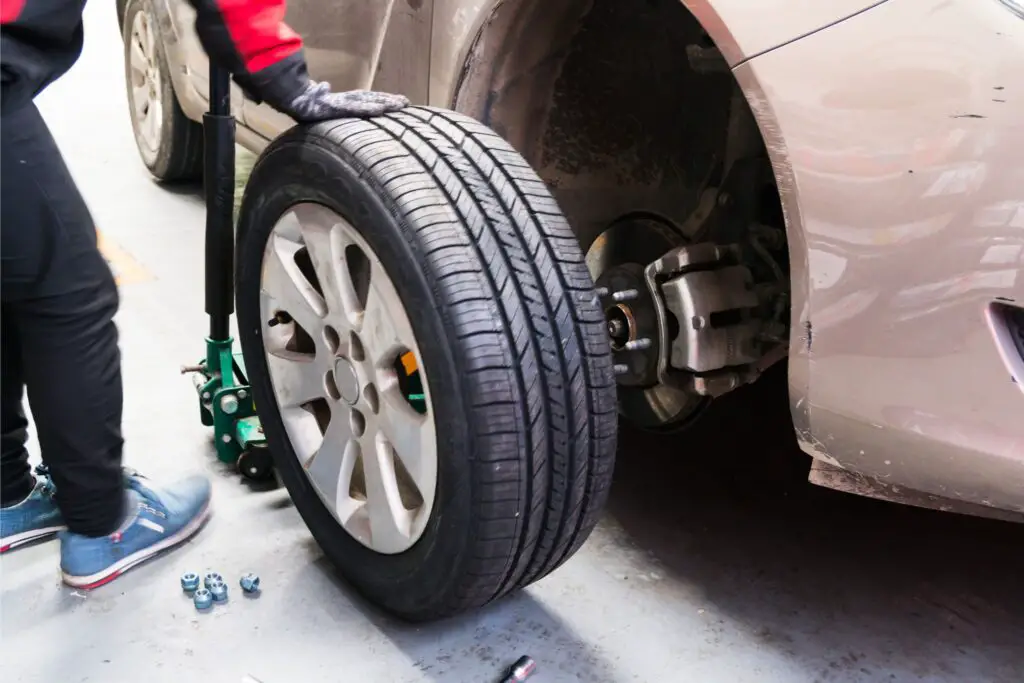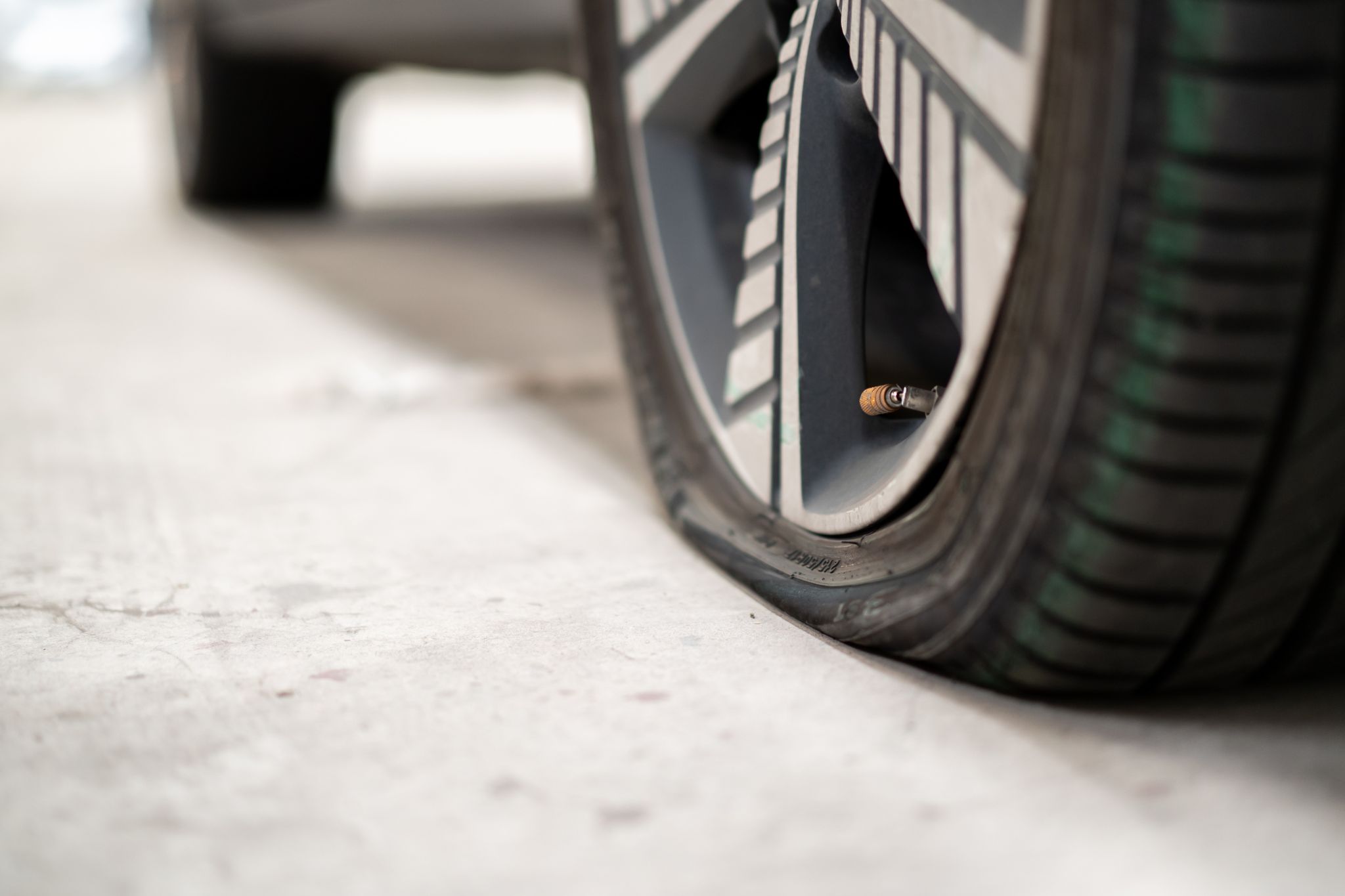Run flat tires are vehicle tires that are capable of allowing you to drive safely even after encountering a tire puncture. But, can you pump up run flat tires?
Run flat tires offer some advantages over conventional tires. These advantages includes, increased safety in the event of puncture as well as prevent any loss of time to changing deflated tires.
Like all other tires, run flat tires need air pressure for an efficient performance – but they can also be driven for up to 50 miles at low speeds (about 50 miles per hour) without air.
Essentially, similar to conventional tires, they too can be pumped up, especially where they deflate from natural causes and not due to any malfunctioning.
What Are Run-Flat Tires?
Run flat tires are pneumatic tires that can effectively take you home across several miles even after a puncture by just driving at the recommended speed limit which is 50 miles per hour(mph).
These tires offer increased safety, and less inconvenience by sparing you from having to stop and change tires after a puncture. They also save on weight and space during storage. They are the products of a new tire technology that enjoys wide global acclaim.
Run flat tires are equipped with re-inforced sidewalls that provide extra support to the tire. This provides temporary support to the tire and keeps it from collapsing in the event of puncture.
They offer an added measure of convenience and peace of mind during your long drives.
(Read Also: Can I Put A 2.1 Tire On A 1.95Rim? Find Out)
Can You Fill Run Flat Tires With Air?


You’ve probably been wondering, can I fill run flat tires with regular air? The short answer is yes, yes you can – provided they deflate gradually due to natural causes.
Run flat tires are meant to help push you for a few more miles (around 50 miles) at slow speeds to help get you out of a tricky situation.
Inflating run flat tires helps push a few more miles on top of the guaranteed 50 miles, ensuring even better safety and convenience to you and all other occupants.
Despite this, run-flat tires should not be driven indefinitely after losing air pressure. Upon driving on a deflated tire, it should be inspected by a mechanic and replaced if necessary.
Please note, these tires may not be repaired if they are damaged. For example, if they are punctured, it may not be possible ton repair it, and will need to be replaced.
How Do Run-Flat Tires Work?
They work by continuing to run smoothly in the event of sudden or gradual deflation. Any vehicle fitted with run-flat tires can continue to move despite any loss of tire pressure.
However, unlike regular tires which require air to stay hard, run-flat tires have a kind of reinforced sidewall as a result of which they stay hardened even without any air in them.
This reinforced sidewall keeps the rubber hard without any air pressure. Allowing you to drive out of any sticky situation you may be under.
How Long Do Run-Flat Tires Last?
The life span of run-flat tires vary depending on a number of factors such as, road surfaces, driving conditions, tire maintenance, and more.
These tires last for at least five years with careful use or cover about 60,000 miles.
If you run flat tires are deflated due to a puncture, it may not be possible to repair them and therefore you may be required to get a new one.
The lifespan of a run-flat tires can be impacted by various factors but with proper care and maintenance – the longer they can last.
Always ensure your run flat tires are checked regularly by your local mechanic and proper maintenance and care accorded to them. These will go along way in determining how long your run tires will last.
How Do I Know If My Run-Flat Tires Are Punctured?
This is difficult to know due to their toughened sidewalls which are not affected even without any air pressure in it despite bearing heavyweights.
To ascertain when they are punctured, you will have to use a pressure monitoring system and check their pressures regularly. (Read Also: Can You Put Mud Tires On A 2wd Truck)
Otherwise, it will be almost impossible to know when your run-flat is punctured. In some cases, you might hear a hissing sound of escaping air which is a sign of a puncture, or if you notice any cuts, holes, or objects sticking out of the tire.
Trending Searches
- Can I Drive 200Miles On A Donut
- Can You Pop A Tire With A Knife
- Can I Put Road Tires On A Mountain Bike
Is It Possible To Have A Flat Tire Without A Puncture?
Of course, it is. This is primarily because tires deflate not only through punctures but natural causes too, such as the air escaping through any minute spaces that may exist between the rims and the tires, especially after being heated in the sun for long periods.
Your tire can also deflate when the air valve through which you pump the tire is faulty. There may also be a crack or hole in your rim through which the air in the tire can gradually escape too.
Can You Repair Run-Flat Tires?


Whether you can repair a run-flat tire or not depends on some factors actually. For one, run-flat tires can be rendered unusable due to either a puncture or other road hazards.
However, before you can repair them, you ought to consider vehicle speed, load, the amount of inflation pressure loss as well as ambient temperature.
The extent and location of the puncturing object are also important with regards to whether you can repair them or not.(Read Also: Will Discount Tire Buy Takeoffs?)
All in all, run-flat tires are not repairable if that is stated on their sidewall.
Similarly, if the tire is driven when its inflation pressure falls below 15 PSI and also if there is abrasion damage on the outside or inside of the tire or other similar conditions of rubber defects.
You should endeavor to have a trained technician do it so as to avoid complications which include voiding your tire’s warranty.
Trending Searches
Can I Drive 200Miles On A Donut
Are Run-Flat Tires Better Than Regular Tires?
Though they offer reliable insurance against getting stranded due to any flat tire and thus enable you to get home safely, in addition to the fact that they also save space and gas, they nevertheless have their downside too.
Firstly, they are costly and may not always be repairable as well. Furthermore, they limit your driving speed and length of distance covered. Another complaint with them is that they are prone to making a clicking noise while driving.
With regards to whether they are better than regular tires or not, it is difficult to rate them higher than regular tires. Consequently, run-flat tires are really good but they cannot be said to be better than regular tires.
What Are The Disadvantages Of Run-Flat Tires?
Run-flat tires are quite good and indispensable considering the services they render. However, they have disadvantages too. One, they are more expensive than all other tires by about 40 to 75 percent or even more.
Secondly, they are so heavy that they can reduce fuel economy thereby leading to higher expenditure on gas.
Their treads do not last as long as in other tires and they also do not grip the road well, particularly in cold temperatures. Finally, run-flat tires do not provide as comfortable a drive as other tires and they can be noisy too.
Is It Illegal To Have Run-Flat Tires And Normal Tires Together?
No, it is not, however, for you to have safe handling of the car and also prevent damage to other parts, all four tires must match very closely in type, tread depth, and size. For this reason, when you mix them with normal tires, stability may be compromised.
That is because run-flat tires are built with reinforced sidewalls which makes them stiffer. If there is any significant difference between your front and rear tires’ sidewall flex, your car is bound to be imbalanced.
What Are Self-Sealing Tires?
Self-sealing tires are not the same as run-flat tires in the sense that while run-flats can operate without air, self-sealing tires cannot. This type of tire has a layer of sealant inside them that can maintain air pressure in the event of any puncture.
Should you get a nail puncture in a self-sealing tire, the sealant will promptly fill the puncture provided it is near the center of the tread and is not bigger than 5 mm in size. However, their biggest advantage is that they resemble traditional tires.
These tires can be mixed and matched with standard tires and the shelf life of the tire remains the same.
They are more expensive than regular tires and are not always available on demand except in big cities. They also have more downsides than upsides
How Do You Replace Run-Flat Tires


You can easily replace run-flat tires provided you meet the manufacturer’s recommendations.
Do not forget that the different tires are designed to keep a vehicle safe and under control too, for a limited distance, even after a puncture because they don’t rely on air pressure to retain their shapes and qualities.
When compared to regular tires, run-flat tires have thicker and more reinforced sidewalls which are made of heat-resistant rubber that will support both the weight of the vehicle and the passengers.
Before making any tire replacements, consider certain things such as the fact that cars that come with run-flats are hardly equipped with kits for emergency mobility like spare tires and rim or jack.
Equipment like TPMS( Tire Pressure Monitoring System), alarms, and internal programming may be affected when replacing run-flats with regular tires.
Also, choose tires of the same size, speed rating, load capacity, and inflation pressure requirements as specified by the vehicle manufacturer before any replacement.
Frequently Asked Questions(FAQ)
Can you plug a run flat tire
Run-flat tires cannot be repaired if they lose air pressure. Run-flat tires with punctures or other damage that causes them to lose air pressure should be replaced, not repaired. Due to their stiffer sidewalls, run-flat tires can support the weight of a vehicle even when they are flat.
Can you patch a run flat tire
Nope, run flat tires can not be patched. They have stiffer sidewalls that can support the weight of a vehicle even when they are flat. It’s not recommended to patch a run flat tire but to rather replace it with a new one.
can i mix run flat tires with regular tires
You should never mix run-flat tires with conventional tires unless in instances of an emergency or a temporarily fix. Conventional tires do not have run-flat capability as well as their handling characteristics. It’s recommended to use all four tires of your vehicle to ensure optimal performance and handling.
Do run flat tires make noise when flat
It’s not uncommon for run-flat tires to remain flat even when they have lost air pressure, so you may not hear any noise when they are flat.
There may, however, be a difference depending on the type of run-flat tire and the driving conditions.
Some run flat tires may produce a thumping noise when they are flat or underinflated. Especially, when you are driving at high speeds or in rough roads.
Same applies to severely damaged tires, they may produce a different type of noise. An indication that it may be time to replace the tire.
What PSI Should Run Flat Tires Have?
Though the user manual should help you with this information since it varies among vehicles, it is generally known that run-flat tires should have a PSI of about 32 PSI for the front wheels and 35 PSI for the rear tires as long as the vehicle speed does not exceed about 100 mph and an average load not more than the capacity of the vehicle.
Do Run – Flat Tires Need More Pressure?
No, they don’t. The user manual will inform you of the tire pressure gauge that must be maintained at all times. This recommended pressure does not necessarily exceed what air pressure other tires require.
So, run-flat tires do not require more air pressure than other tires. (Read Also: Is Uneven Tire Pressure Bad?Find Out)
How Do You Patch And Plug Run-Flat Tires?
For tire injuries such as a nail in the tread, you can always patch it up, but be sure to have a good shop do it.
To repair run-flat tires, fill the puncture hole from inside the tire before you apply a patch on top of the repair, but do not have it plugged since plug repairs do not involve taking the tire off its wheel for necessary inspection.
Are Run-Flat Tires Any Good?
Yes, they are. For one, they are great insurance against getting stranded whenever you have a flat tire which will enable you to continue driving.
In addition, they save space and gas too. However, they can be costly to replace since they are more expensive than conventional non-run-flat tires.
Furthermore, run-flat tires save you from the burden of carrying a spare tire in your trunk.
Can Run-Flat Tires Be Plugged?
Run-flat tires can be patched in some instances if certain conditions prevail, but you are advised never to plug run-flat tires. Ever.
Can I Put Run-flat Tires On Regular Rims?
Yes, you can put run-flat tires on regular rims as far as all the dimensions of both the tires and the rims are exactly the same. If there is any difference in their sizes or shapes whatsoever, you cannot do so.
Can You Pump Up Run Flat Tires – Conclusion
Tires are bound to develop problems no matter how we take care of them and that is the reason different approaches have been made available to care for such needs when necessary such as by using run-flats, self-sealing tires, and lots more.
By their designs and rubber integrity, run-flat tires are able to hold sway even after getting a puncture to ensure that you reach where you can get help. They are able to do this by having highly fortified sidewalls made of toughened leather.
Self-sealing tires, unlike run-flats, are not made of fortified rubber, but rather are lined on the inside with a chemical substance that promptly seals any hole in the tire and re-inflates it to make sure that your journey is not disrupted.
The article has also spoken in detail on the requirements to be looked out for before you replace any tire. Similarly, you have been informed on how to properly use various kinds of tires in order to get the best out of them.
For instance, you must not drive for more than 50 mph while on run-flat tires or through any distance exceeding 50 miles too. If you hearken to all these, you are liable to get the best out of your tires.
This post contains affiliate links. Read the full disclosure here.


I am passionate about all things automotive and have a deep understanding of the topic. As a mechanic, I use my free time to share knowledge of everyday challenges that any car owner can experience – helping you make informed decisions about tires.

